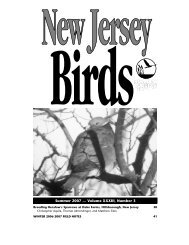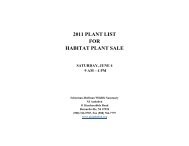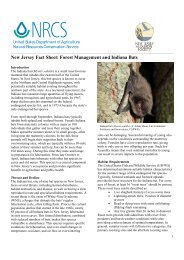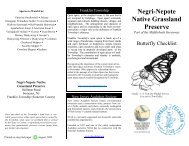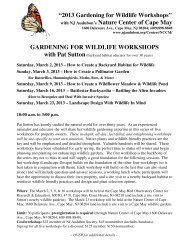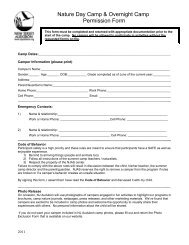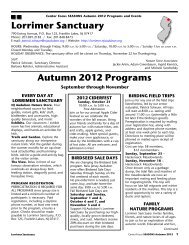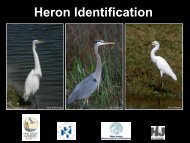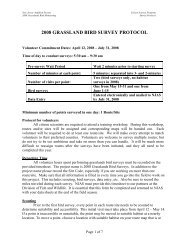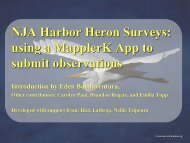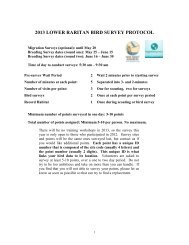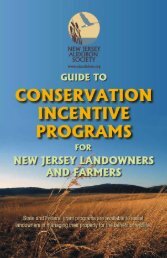Birding for Boaters - New Jersey Audubon Society
Birding for Boaters - New Jersey Audubon Society
Birding for Boaters - New Jersey Audubon Society
Create successful ePaper yourself
Turn your PDF publications into a flip-book with our unique Google optimized e-Paper software.
Bird-friendly Boating Practices• Minimize boat and personal watercraft wakes,especially in shallow water areas. Boat wakescan cause shoreline erosion, increase turbidity,and damage important sea grasses thatprovide nesting and <strong>for</strong>aging sites <strong>for</strong> avariety of estuary species.• Take advantage of pump-out facilities—do notdischarge wastewater holding tanks into ourwaterways. Obtain a free guide showing locationsof all <strong>New</strong> <strong>Jersey</strong>’s pumpout stations bycontacting NJ Division of Fish and Wildlife’sClean Vessel Act Office at 609-748-2056 or atwww.njfishandwildlife.com/cvadir.htm• Keep trash in secure containers and disposeof it on land. Floatable trash can be mistakenby fish, turtles, and birds as food. Ingestingsuch items may cause death.• Dispose of monofilament fishing line, hooksand lures in a proper manner. Birds and otheranimals may get tangled in the line.• Maintain your boat engine to minimize oilleaks. Use a bilge pillow or other oil absorbentmaterials to reduce oil being pumped intowaterways along with bilge water.• Avoid approaching nest colonies of plovers,terns, and skimmers. Usually these are ropedoff to prevent human disturbance. When birdsleave the nest <strong>for</strong> any length of time fledglingsmay die of exposure to heat/cold or bevulnerable to predation by gulls and crows.NOTE: The NJ Department of EnvironmentalProtection maintains a current animal rehabilitationlist. In the event you find an injured bird oranimal, this list can be accessed at the NJ DEPwebsite—www.state.nj.us/dep/fgw/rehablst.htm.Tips on How to Identify a BirdIn order to identify a bird, one must be willingto watch it. Binoculars help, but are notnecessary. Most birdwatchers use the followingguidelines to help identify a bird they don’tknow.Size. Determine if the bird is bigger or smallerthan other species — especially ones youalready know. Is it the size of a gull, a crow, asparrow, a robin?Shape. Does the bird have an overallstreamlined shape and structure or is it roundand dumpy? Is it long-legged, long-necked orjust the opposite? These are questions you canpose and answer as you look at an unknownbird.Behavior. What is the bird doing? Is it walkingslowly or running along the beach? How doesthe bird feed? Each bird species has its ownbody language and this can be used to helpidentify it — even from a distance.Habitat. The type of habitat in which you seethe bird can often help narrow down thecandidates. Note that the brochure associatesparticular birds with particular habitats.Although these are suggested, birds movearound and there is often overlap in habitat use.Coloration. Look at overall color or colorcombinations to help identify bird species.Does the bird have a particular striking patternto its wings? Does it show speckling or stripingor some other kind of distinctive featherfeatures?Sound. Most birds have specific call notes theyuse to communicate with each other or tosound the alarm <strong>for</strong> predators and/ordisturbance. One can learn to identify a birdspecies just by the call.



